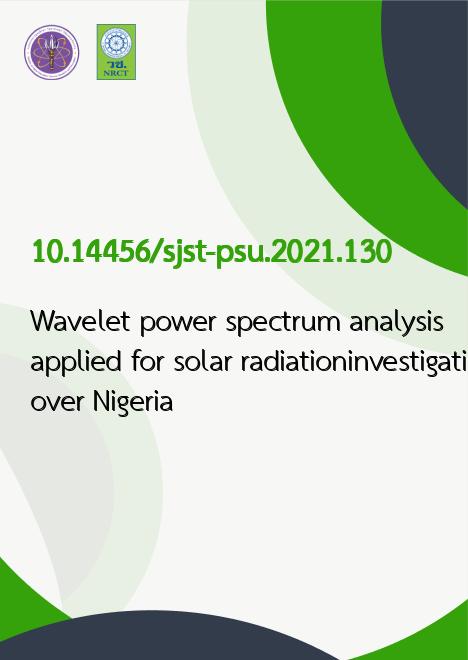
|
Wavelet power spectrum analysis applied for solar radiationinvestigations over Nigeria |
|---|---|
| รหัสดีโอไอ | |
| Creator | 1. Falayi E. O. 2. Adepitan J. O. 3. Oni O. O. 4. Faseyi M. T |
| Title | Wavelet power spectrum analysis applied for solar radiationinvestigations over Nigeria |
| Publisher | Research and Development Office, Prince of Songkla University |
| Publication Year | 2564 |
| Journal Title | Songklanakarin Journal of Science and Technology (SJST) |
| Journal Vol. | 43 |
| Journal No. | 4 |
| Page no. | 993-999 |
| Keyword | clearness index, solar irradiance, wavelet power spectrum, relative sunshine duration and bootstrap |
| URL Website | https://rdo.psu.ac.th/sjstweb/index.php |
| ISSN | 0125-3395 |
| Abstract | Wavelet power spectrum (WPS) techniques were used to evaluate the temporal structure of the clearness index andrelative sunshine duration, using monthly values of clearness index and relative sunshine duration between 1995 and 2010. Thesignificant years are featured by high wavelet coefficients of both the clearness index and relative sunshine duration. Lowwavelet coefficients noticed during the selected years might emerge from the increase in turbidity and cloudiness, indicating thatcloudiness has the greater impact on the solar radiation resulting in weak sky condition. Bootstrap method was also used toacquire regression correlations between clearness index and relative sunshine duration. The correlation coefficient between themonthly values of clearness index and relative sunshine duration for ABK (0.32), ENU (0.31), JOS (0.40), MAID (0.46), OWE(0.25), PH (0.46), SOK (0.65), YOL (0.58). The climatic condition and weather patterns of locations have an impact on theamount solar energy received. |
